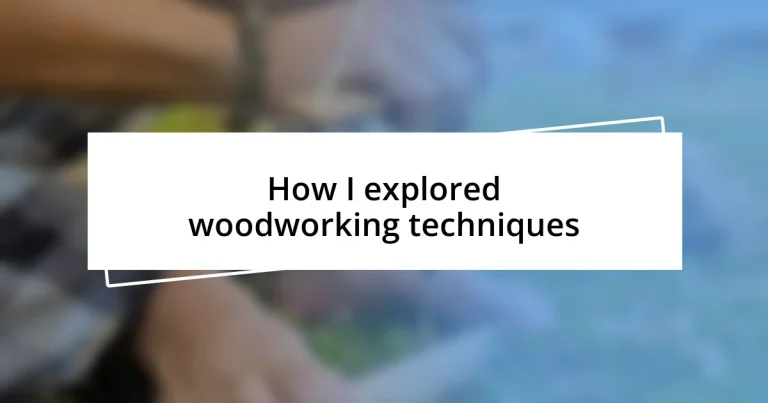Key takeaways:
- The author’s passion for woodworking ignited after discovering an old toolbox, leading to the enrollment in a local woodworking class where the first successful project boosted their confidence.
- Investing in essential tools such as chisels, drills, and clamps significantly improved the woodworking process, fostering precision and enhancing creativity.
- Mastering both basic and advanced techniques, alongside engaging in woodworking communities and seeking feedback, has been crucial for skill improvement and personal growth in the craft.

How I started woodworking journey
My woodworking journey began on a rainy Sunday afternoon, when I stumbled upon an old, dusty toolbox in my attic. It belonged to my grandfather, filled with forgotten tools that sparked a desire within me to learn the art of woodworking. I often wonder, how can something as simple as an old toolbox ignite such a profound passion?
Eager to dive deeper, I enrolled in a local woodworking class. The first day, I felt a mix of excitement and trepidation as I picked up my first chisel. I remember thinking, am I really cut out for this? But as I shaped my first piece of wood, the initial uncertainty melted away, replaced by a sense of accomplishment that was utterly exhilarating.
As I dove into different techniques, from joinery to finishing, each project turned into a personal challenge. I recall creating a simple bookshelf for my living room; it wasn’t just about the wood—it was a reflection of my growth. Isn’t it remarkable how each cut and joint tells a story of progress, perseverance, and, sometimes, a bit of frustration?

Tools every woodworker needs
When I first ventured into woodworking, I quickly realized the importance of having the right tools. It’s amazing how the right equipment can transform your experience, allowing for precision and creativity. I remember my initial frustration with a mismatched set of tools, making simple tasks feel monumental. Investing in decent, reliable tools not only enhances your projects but also boosts your confidence as a craftsman.
Here’s a list of essential tools that every woodworker should have in their arsenal:
- Tape Measure: Accuracy starts here; it’s the foundation of all your measurements.
- Square: Ensures perfect corners; a must-have for any joinery.
- Chisels: They allow for fine detailing and adjustments, bringing your vision to life.
- Hand Saw: Useful for making precise cuts without the noise of power tools.
- Drill: Versatile for both drilling holes and driving screws, essential for assembly.
- Orbital Sander: Saves time and effort while achieving a smooth finish.
- Clamps: Hold everything together while the glue sets; indispensable for any project.
Having these tools has not only helped streamline my process but also instilled a sense of pride in each creation. While wandering through my workshop, I often reflect on how far I’ve come: each tool carries a story, and they all share my journey of growth.

Basic woodworking techniques for beginners
When I began woodworking, mastering basic techniques felt like stepping onto an intricate dance floor. The first skill I tackled was sanding. Initially, I underestimated its importance; however, I discovered that a well-sanded piece of wood not only feels great to touch but also allows finishes to apply evenly. The satisfaction of transforming rough wood to a silky-smooth surface felt incredible—like unveiling a hidden masterpiece.
Another fundamental technique I embraced was joining. Learning to create joints such as butt joints and dovetails opened up a whole new world of possibilities. I remember my first attempt at a dovetail joint; it was messy and far from perfect. Yet, seeing the pieces come together was thrilling. Each successful joint paved the way for more complex projects and brought me closer to my goal of crafting furniture.
Finally, I focused on measuring and marking techniques. Precision is crucial in woodworking, and developing confidence in my measuring skills took time. I recall one instance where I miscalculated a cut, and the piece ended up too short. While it was disheartening, I learned to embrace mistakes as part of my growth. Now, I approach each measurement with patience and a focus on accuracy, which has been invaluable for my projects.
| Technique | Description |
|---|---|
| Sanding | Preparing wood by smoothing its surface for finishing. |
| Joining | Connecting two pieces of wood using various joint types. |
| Measuring and Marking | Ensuring precise cuts and placement to achieve accuracy. |

Advanced techniques for skilled woodworkers
When you’ve developed your basic skills, diving into advanced techniques can feel both exhilarating and intimidating. One of my favorites is lamination, where I learned to bond multiple layers of wood to create a strong, visually appealing surface. I vividly remember the first time I crafted a laminated table top—watching the modest pieces of wood transform into a stunning, curved design made me appreciate the beauty of engineering and artistry coming together. It’s a game changer if you want to push the limits of traditional woodworking.
For those who enjoy a challenge, mastering inlay techniques adds a rich dimension to your work. I recall experimenting with contrasting woods for decorative patterns, which elevated simple projects like a picture frame or jewelry box into true statement pieces. It required precision, patience, and some trial and error, but the moment I saw my inlay fit perfectly, it felt immensely rewarding. Have you ever experienced that thrill of seeing your piece transformed by intricate details? It makes the hard work worth it.
Another advanced technique I’ve embraced is carving, which conveys a level of intimacy and personal touch. I started with small relief carvings and, even today, I fondly remember the first time a design jumped out from a flat surface. It was as if the piece was telling me its own story, and I was merely guiding the way. I often find myself lost in the rhythmic motion of my carving tools, and if you haven’t tried it yet, I highly encourage you to unleash your creativity through this wonderful technique. Each carving can reflect a part of your personality, making your work even more special.

Tips for improving woodworking skills
When I think about improving woodworking skills, one of the first things that comes to mind is practicing repetition. I remember my early days when I would endlessly practice my cuts with different types of saws. Initially, each cut felt daunting, but after repeating the process, I became more confident and precise. Have you ever noticed how the more you do something, the better it gets? It’s incredible how repetition can transform a shaky hand into a steady one.
Another effective method is seeking feedback. I often found that sharing my projects with fellow woodworkers led to invaluable insights. One of my friends pointed out a small detail on a cabinet I had completed that I hadn’t even considered. Not only did it improve my technique, but it also deepened my understanding of aesthetics in woodworking. I believe that sometimes a fresh set of eyes can illuminate aspects we might overlook ourselves. How do you gather constructive criticism? It’s a vital part of growing in this craft.
Lastly, immersing yourself in woodworking communities can be incredibly beneficial. I made a habit of following forums and attending local workshops, which expanded my knowledge beyond just technique. The stories I heard from other woodworkers, each sharing their triumphs and mistakes, deepened my appreciation for the craft. It made me realize that we’re all on this journey of improvement together, learning from one another’s experiences. Have you considered joining a woodworking group? The camaraderie and shared knowledge can be a game changer!

Common woodworking mistakes to avoid
Avoiding common woodworking mistakes is crucial for a smoother experience in the workshop. One of my biggest blunders was underestimating the importance of measuring twice and cutting once. In my eagerness to see my project take shape, I once rushed through measurements. The result? A piece that didn’t fit properly and a few wasted hours. Yes, I learned the hard way that taking the time to double-check can save not just materials, but also frustration.
Another mistake many beginners, including myself, often make is failing to properly prepare wood before starting a project. I remember working on a simple bookshelf when I overlooked the need to sand down rough edges. The rough surface not only marred the final finish but also made the construction process more challenging. Have you ever tried to glue two uneven surfaces together? It can be a real headache! Taking time to prep your materials can make your project both easier and more aesthetically pleasing.
Lastly, let’s talk about neglecting safety measures. Early in my woodworking journey, I was too focused on achieving the perfect cut to remember to wear safety goggles. I had a close call when a tiny sliver of wood flew into my eye, and trust me, it wasn’t a pleasant experience. It’s essential to remember; no project is worth risking your safety. How often do we let excitement overshadow caution? I’ve learned to treat safety as a priority, and it’s something I encourage every aspiring woodworker to embrace as well.

Projects to showcase your skills
When I think about showcasing woodworking skills, the first project that pops into my mind is building a simple coffee table. I remember the rush of excitement as I transformed raw lumber into a beautiful piece of furniture. The satisfaction of planning the design, measuring each cut, and finally assembling it was incredibly rewarding. Have you ever felt that thrill when creating something functional? It’s a joy like no other.
Another fantastic project for demonstrating your abilities is crafting a decorative shelf. I once decided to create a floating shelf for my living room, which not only displayed my favorite books but also highlighted my skill in joinery. Attaching the shelf securely required careful precision, but the real magic happened when I stepped back and admired my handiwork hanging on the wall. Don’t you love it when a project serves both purpose and beauty? It becomes a conversation piece and a source of pride.
Lastly, consider designing and building a small outdoor bench. I fondly recall the day I finished mine; it felt amazing to create a space where family and friends could gather outdoors. As I shaped the wood and applied the finish, I thought about all the memories that would be made around the bench. Have you thought about the joy your projects can bring to others? These types of projects not only showcase skills but also encapsulate emotions, making your work truly meaningful.














